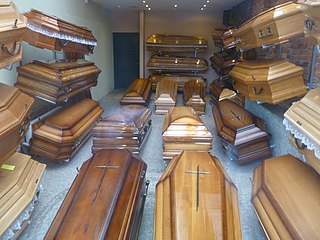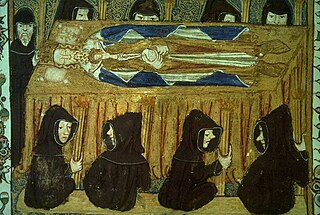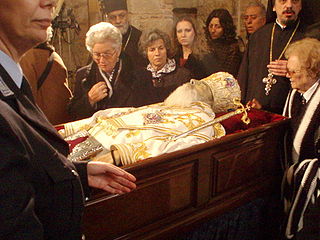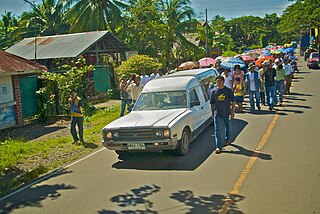
A funeral is a ceremony connected with the final disposition of a corpse, such as a burial or cremation, with the attendant observances. Funerary customs comprise the complex of beliefs and practices used by a culture to remember and respect the dead, from interment, to various monuments, prayers, and rituals undertaken in their honour. Customs vary between cultures and religious groups. Funerals have both normative and legal components. Common secular motivations for funerals include mourning the deceased, celebrating their life, and offering support and sympathy to the bereaved; additionally, funerals may have religious aspects that are intended to help the soul of the deceased reach the afterlife, resurrection or reincarnation.

A funeral home, funeral parlor or mortuary, is a business that provides burial and funeral services for the dead and their families. These services may include a prepared wake and funeral, and the provision of a chapel for the funeral.

Burial, also known as interment or inhumation, is a method of final disposition whereby a dead body is placed into the ground, sometimes with objects. This is usually accomplished by excavating a pit or trench, placing the deceased and objects in it, and covering it over. A funeral is a ceremony that accompanies the final disposition. Evidence suggests that some archaic and early modern humans buried their dead. Burial is often seen as indicating respect for the dead. It has been used to prevent the odor of decay, to give family members closure and prevent them from witnessing the decomposition of their loved ones, and in many cultures it has been seen as a necessary step for the deceased to enter the afterlife or to give back to the cycle of life.

Mourning is the expression of an experience that is the consequence of an event in life involving loss, causing grief, occurring as a result of someone's death, specifically someone who was loved, although loss from death is not exclusively the cause of all experience of grief.

A coffin is a funerary box used for viewing or keeping a corpse, either for burial or cremation.
Embalming is the art and science of preserving human remains by treating them to forestall decomposition. This is usually done to make the deceased suitable for viewing as part of the funeral ceremony or keep them preserved for medical purposes in an anatomical laboratory. The three goals of embalming are sanitization, presentation, and preservation, with restoration being an important additional factor in some instances. Performed successfully, embalming can help preserve the body for many years. Embalming has a very long and cross-cultural history, with many cultures giving the embalming processes religious meaning.

A grave is a location where a dead body is buried or interred after a funeral. Graves are usually located in special areas set aside for the purpose of burial, such as graveyards or cemeteries.

The majority of funerals in Japan include a wake, the cremation of the deceased, a burial in a family grave, and a periodic memorial service. According to 2007 statistics, 99.81% of deceased Japanese are cremated.

Lying in state is the tradition in which the body of a deceased official, such as a head of state, is placed in a state building, either outside or inside a coffin, to allow the public to pay their respects. It traditionally takes place in a major government building of a country, state, or city. While the practice differs among countries, in the United States, a viewing in a location other than a government building, such as a church, may be referred to as lying in repose. It is a more formal and public kind of wake or viewing. Lying in state often precedes a state funeral.

A funeral director, also known as an undertaker or mortician, is a professional who has licences in funeral arranging and embalming involved in the business of funeral rites. These tasks often entail the embalming and burial or cremation of the dead, as well as the arrangements for the funeral ceremony. Funeral directors may at times be asked to perform tasks such as dressing, casketing, and cossetting with the proper licences. A funeral director may work at a funeral home or be an independent employee.

Lying in repose is the tradition in which the body of a deceased person, often of high social stature, is made available for public viewing. Lying in repose differs from the more formal honor of lying in state, which is generally held at the principal government building of the deceased person's country and often accompanied by a guard of honour.
Bereavement in Judaism is a combination of minhag (traditions) and mitzvah (commandments) derived from the Torah and Judaism's classical rabbinic literature. The details of observance and practice vary according to each Jewish community.

Natural burial is the interment of the body of a dead person in the soil in a manner that does not inhibit decomposition but allows the body to be naturally recycled. It is an alternative to typical contemporary Western burial methods and modern funerary customs.

Death is dealt with differently in cultures around the world, and there are ethical issues relating to death, such as martyrdom, suicide and euthanasia. Death refers to the permanent termination of life-sustaining processes in an organism, i.e. when all biological systems of a human being cease to operate. Death and its spiritual ramifications are debated in every manner all over the world. Most civilizations dispose of their dead with rituals developed through spiritual traditions.
The death care industry in the United States includes companies and organizations that provide services related to death: funerals, cremation or burial, and memorials. This includes for example funeral homes, coffins, crematoria, cemeteries, and headstones. The death care industry within the U.S. consists mainly of small businesses, although there has been considerable consolidation over time.
The Funeral Rule, enacted by the Federal Trade Commission on April 30, 1984, and amended effective 1994, was designed to protect consumers by requiring that they receive adequate information concerning the goods and services they may purchase from a funeral provider.
A funeral procession is a procession, usually in motor vehicles or by foot, from a funeral home or place of worship to the cemetery or crematorium. In earlier times the deceased was typically carried by male family members on a bier or in a coffin to the final resting place. This practice has shifted over time toward transporting the deceased in a hearse, while family and friends follow in their vehicles. The transition from the procession by foot to procession by car can be attributed to two main factors; the switch to burying or cremating the body at locations far from the funeral site and the introduction of motorized vehicles and public transportation making processions by foot through the street no longer practical.
An online memorial is a virtual space created on the Internet for the purpose of remembering, celebrating, or commemorating those who have died. An online memorial may be a one-page HTML webpage document giving the name of the deceased and a few words of tribute, an extensive information source, or be part of a social media platform where users can add their own words and photos.

During the Pre-Hispanic period the early Filipinos believed in a concept of life after death. This belief, which stemmed from indigenous ancestral veneration and was strengthened by strong family and community relations within tribes, prompted the Filipinos to create burial customs to honor the dead through prayers and rituals. Due to different cultures from various regions of the Philippines, many different burial practices have emerged. For example, the Manobos buried their dead in trees, the Ifugaos seated the corpse on a chari before it was brought to a cave and buried elsewhere. The most common forms of traditional burials are supine pits, earthenware jars, and log coffins, and have been a topic of interest among Philippine archaeologists since the early 20th century.













